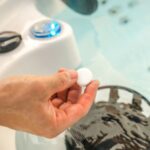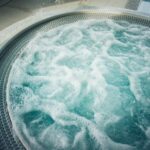One of the most critical hot tub maintenance checklists is balancing your water chemistry. Part of this water chemistry is your hot tub water’s calcium hardness.
Calcium Hardness is a significant marker of the chemistry of the hot tub water, yet it is occasionally disregarded or neglected. It can have severe effects if this is either high or extremely low. Component damage, skin and eye irritation, and scaling are all typical results of varying calcium hardness levels.
If you don’t want to experience these consequences and only want a warm soak in your relaxing hot tub, then it is time to check the calcium hardness in your hot tub and perform necessary actions if it’s too high or too low. This article is your practical guide in doing this, so f you don’t know how to tune in to this article until the end.
What Is Calcium Hardness In Hot Tubs?
Let us start by understanding what calcium hardness is in hot tubs.
Calcium is an element that occurs naturally and is found in all water bodies. Because the water used in hot tubs is drawn from groundwater, rivers, and streams, it makes sense that dissolved calcium is also present in hot tub water.
Also referred to as total hardness, this refers to the dissolved magnesium and calcium in the spa water. In a hot tub, the basic suggested range is 200 to 400 ppm or parts per million. This may change because of the hot tub surface and the chemicals used to maintain the spa. A bromine-using acrylic spa should have calcium levels between 175 to 225 ppm.
How To Know a Hot Tub’s Calcium Hardness
It is relatively easy to check the calcium levels of your hot tub. You can employ these three methods to check the total hardness of the water in your hot tub.
- The quickest and simplest way to evaluate the water in a hot tub is with test strips.
- A liquid test kit is also another way. Although it is more expensive and time-consuming than testing kits, occasionally, they are more accurate. Ensure once more that the kit measures the calcium levels.
- Your last resort is to find any shop that offers to do a test for you. Getting the water properly tested at least two times a year is advised.
How To Increase Calcium Hardness That Is Not Enough

It is important to note that what you be achieved is a balanced calcium hardness level. Low calcium hardness can be dangerous for you and your equipment.
You risk equipment corrosion if you allow a lower calcium hardness. It applies to the heaters, the jets, and even some of the shell’s structural elements. Hot tub foaming can also be caused by too-soft water, so you’ll have two issues to address.
Raise calcium hardness using these steps.
Apply Calcium Chloride
It is a supersaturated form of calcium offered in 77% (hydrated) and 100% (anhydrous) levels. Calcium chloride gives you complete control over the tub’s calcium content if you don’t use other calcium-containing compounds in your water.
Here is how you apply Calcium Chloride to raise calcium hardness:
- Using a test strip or a liquid test kit, turn off the electricity in the tub and check the water quality. Check the water’s balance and take note of the calcium hardness level.
- Calculate the dosage that your tub needs. As a general guideline, 2 oz of calcium chloride increases the ppm of 1,000 gallons of water. Follow the dosage recommendations on the package for those using Calcium Increaser, as they differ depending on the product.
- Fill a bucket with water, then dissolve the calcium chloride to create a diluted solution. Use a stick to combine and dissolve the calcium thoroughly.
- Fill the hot tub with the solution.
- If some granules haven’t been wholly dissolved, scrub the tub’s walls. It accelerates the process of blending the solution with the water.
- For one or two hours, cycle the tub. Then test the water again to check for the calcium hardness level.
How To Decrease Calcium Hardness In Hot Tub
Too much calcium can lead to cloudy water, scale formation on the water’s surface, and skin drying since it can clog the pores, making it hard for you to balance the water chemistry in the future.
To decrease your total hardness in a hot tub water to the normal total hardness, these are the steps you need to take.
Apply A Flocculant
A flocculant coagulates the calcium ions in the water. You will need to take it from the tub once it sinks to the bottom and gathers up.
Another option is a spa clarifier, which functions similarly to a flocculant. Although it works more slowly, the particles float on the water’s surface, making it easier to remove them using a suction net or a filter.
Here is how you apply a Flocculant:
- Switch the hot tub off.
- For the recommended flocculant dosage, refer to the labels on the bottle.
- Fill the tub with the appropriate amount of flocculant.
- For the flocculant to circulate in the water, operate the tub for an hour.
- Clear the tub’s floor of any particles that have accumulated there. They could kick up as you remove them. If so, allow them to subside before attempting again.
- Inspect the filter to see whether any flocculant gathered there during circulation. If it’s there, a garden hose spraying down the filter’s cartridges will work for you.
If there is no available flocculant in your place and you have run out of options, the best thing you can do is simply drain your hot tub and refill it with fresh water.
Frequently Asked Questions
Here are some frequently asked questions to guide you in checking the calcium levels of your hot tub.
What Causes High Calcium In Hot Tubs?
When the pH level is not balanced, it affects the TA level. Another factor is the hot water temperature. The calcium induces out-of-suspension as the temperature rises. It could arise if you don’t routinely check the water temperature in your tubs.
Does Baking Soda Cause High Calcium Hardness?
Baking soda does not enhance calcium hardness; it helps balance the pH of the spa and pool water. But it is not advised to add baking soda to water after putting calcium carbonate in it for a few hours because it would make the water murky.
Should Hot Tub Water Be Hard Or Soft?
Hot tub water should have a calcium hardness between 180 and 200 ppm. It should be hard or soft.
Conclusion

Regularly check your water chemistry, including the total or calcium hardness, is crucial to your hot tub maintenance. Always remember that the goal is to have a stable and average level. Both extremes of being too hard or too soft water are not good. If you find your hot tub in either of these cases, make sure o follow the methods presented above.

